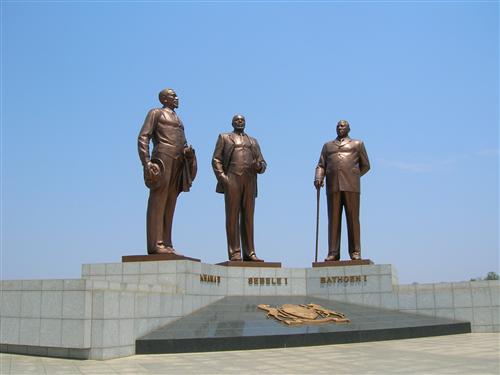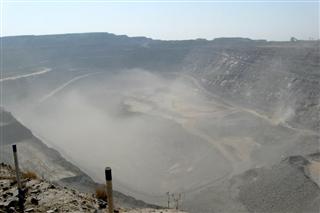Basic data
Botswana is a riparian country to the Limpopo, Okavango, Orange-Senqu and Zambezi River basins with a relatively sparse population of approximately 2,065 million inhabitants, distributed across an area of 581 730 km². The majority of the population in Botswana belongs to the major Tswana ethnic group, also known as the BaTswana. Other ethnic groups include Kalanga 11%, Basarwa 3%, others, including Kgalagadi and white 7%.
The majority of Botswana’s population resides in the South Eastern region, which includes the capital Gaborone with a population of about 240 000 people. Population growth is moderate with 1,1% per year; the population is relatively young, with a median age of 22,3 years in 2011. Botswana is strongly affected by the HIV-AIDS pandemic; in 2009 approximately 24,8% of adults were living with HIV. The Human Development Index (HDI) for Botswana was 0,633 in 2011, ranking the country 118th out of 187 countries with data (UNDP HDR 2011).

The Three Dikgosi, the founding chiefs from Botswana, who travelled to Great Britain during the Independence transition in order to stop the incorporation of the land that is now Botswana into Rhodesia (Zimbabwe) or the Union of South Africa.
Source:Hatfield 2008
( click to enlarge )
An Economic Miracle
Botswana has been an economic miracle. One of the ten poorest countries in the world at independence in 1966, it has since become a middle income country, mainly due to the discovery and exploitation of the world’s richest diamond fields (see box below). Most of the country’s economic successes can be attributed to diamond mining that accounts for about35% of the GDP and 70-80% of the export earnings.
Box: Debswana
Debswana is a 50/50 partnership between the Botswana Government and Swiss-based De Beers Centenary, a 100% subsidiary of DB Investments/De Beers SA in Luxembourg. The Botswana Government has a 15% interest in DB Investments which it took over from Debswana. As of 2003 the company had an overall workforce of about 5 500: 180 at Damtshaa, 2 150 at Jwaneng, and a total of 3 137 at the Orapa and Letlhakane operations. Debswana is the world’s leading producer of gem diamonds, contributing about 30% of world output by value, from four mines. Following detailed exploration by De Beers in the 1960s, the Orapa diamond mine, located about 240 km west of Francistown, began production in 1971. Since then, Debswana Diamond Company Ltd has opened three more open pits: Letlhakane, which is 50 km from Orapa, in 1977; Jwaneng, 120 km west of the capital city, Gaborone, in 1981–2; and the P225 million Damtshaa, which is 20 km east of Orapa.
Source: Mining-technology.com 2009
Other key economic sectors in Botswana include tourism, cattle raising, subsistence farming and financial services. Botswana’s economic success is also a result of prudent fiscal policies, international financial and technical assistance, and a cautious foreign policy.
The part of the Orange-Senqu River basin located in Botswana is an arid region and does not contribute significantly to the economic development of Botswana.
 Jwaneng open-pit diamond mine, Jwaneng, Botswana. Source:Cretep 2007 ( click to enlarge ) |
Socio-economic Challenges
Despite this success, critical economic and social challenges confront Botswana: the need to diversify the economy; ability to implement policies, programmes and projects; high unemployment; poverty; vulnerability to weather changes, and changes in the world prices of its major commodities.
Urban regions in Botswana have been the focus of development, while rural regions are characterised by low productivity, deteriorating natural-resource bases, absolute poverty, high mortality rates and lower life expectancy. As a result, there has been migration from rural to urban areas, with the latter growing at up to 10% annually. Some of the major causes of relocation include:
-
Low agricultural commodity prices, which make agriculture an unattractive occupation even in good rain seasons, coupled with weak agricultural marketing systems and policies
-
Land-use conversion from subsistence to commercial tenure, leading to either absorption or displacement of certain rural communities
-
Rapid rural population growth, leading to population pressure, which manifests itself as unemployment, over-exploitation and degradation of the environmental resource base
-
Periodic droughts and desertification, which have forced the rural population to relocate to the larger centers to access a reliable water supply, drought relief rations, and work
-
Termination of the formal international migratory labour system, by the Republic of South Africa, to afford employment to its citizens
A significant number of urban households engage in farming and consider their rural home as their true home. This sense persists for a very long time after arrival in town and over great distances. Nevertheless, there is severe unevenness of development between the rural and urban areas, with 55% of the rural population below the poverty line compared to 46% in urban villages and 29% in urban areas. A significant percent of the population still lives on less than US$2 a day. At the root of rural poverty lies a structural limitation: a lack of agricultural diversity renders Botswana’s resources difficult to divert into more sustainable uses, cattle being the only effective means of attaining wealth above subsistence.
Poverty Reduction Strategies
Since Botswana’s independence in 1966, its challenges have included rural development and poverty alleviation. The Remote Area Development Programme was launched in 1978 after it was realised that proactive measures were needed to assist economically marginalised communities. Its objectives are:
-
To intensify development of remote settlements to bring them up to parity with other villages in the country
-
To promote production-oriented income and employment generating activities
-
To promote social, cultural and economic advancement of Remote Area Dweller communities
-
To enhance these communities’ access to land
In 2003, the Government of Botswana took further action and created a National Strategy for Poverty Reduction (NSPR). The overall goal of this strategy is to eliminate income poverty by 2016. The strategy:
-
Sets poverty reduction as its overarching goal consistent with the country’s commitment to "build a compassionate, caring and just nation"
-
Charts the strategic pathways for poverty reduction, primarily through broad-based labour-absorbing economic growth, the provision of basic quality social services to the poor, the promotion of cost-effective pro-poor social safety nets, an enhanced effective response to the HIV/AIDS epidemic, and strengthening institutions for the poor
-
Provides a multi-sectoral approach for overseeing the design, implementation and monitoring of poverty reduction interventions
To find out about Botswana's progress towards achieving its development goals, please refer to the Human Development Indicators pages of this theme.
